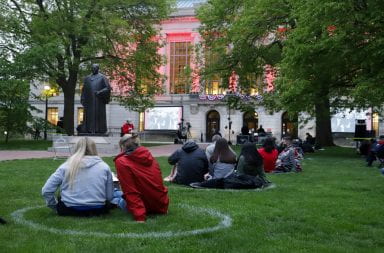
Ohio State President Kristina M. Johnson said any major university decisions moving forward will be informed by the total number of students who test positive and Ohio State’s rate of transmission — not the positivity rate on its own. She said the transmission rate has decreased into a good range and feels confident with its current state. Credit: Sarah Szilagy | Campus Editor
Following the announcement that in 24 hours, almost 10 percent of off-campus and more than five percent of on-campus students tested positive for COVID-19, Ohio State President Kristina M. Johnson said any major university decisions moving forward will be informed by the total number of students who test positive and Ohio State’s rate of transmission — not the positivity rate on its own.
In an interview with The Lantern Thursday, Johnson said the university will move forward in person and on campus as long as the transmission rate — the rate at which people positive for COVID-19 infect others — remains around one infection to one new infection. She said they are seeing the transmission rate decrease into a good range and feels confident with its current state.
“I feel that it is our plan of record that we are watching it every day and we will make a decision if we see the transmission factors shoot way up,” Johnson said. “Right now we feel it’s safe to be here.”
Johnson said keeping the transmission rate low is crucial given the size of the university and its current contact tracing capacity. She said tracking people positive for COVID-19 and quarantining people with whom they have come in close contact is easy in small groups, but Ohio State needs to hire more full-time contact tracers — which it is in the process of doing — to handle the amount of testing being done.
She said she is cautiously optimistic that the combination of the current transmission rate and the testing, quarantining and contact-tracing capacities at Ohio State will allow the university to continue working and learning in its current structure. Johnson also said students who go home may not have the same access to the testing and contact-tracing capabilities that they would at the university.
“I’m looking forward to staying with face-to-face instruction and hybrid and remote in the same ratio that we have now,” Johnson said. “But that could change and I want to be agile because the number one thing’s going to be the safety of our students, faculty and staff.”
Johnson said the 24-hour off-campus positivity rate, which was 9.66 percent as of Wednesday, will appear higher as the surveillance testing in that area began Monday and the sample size is smaller than other metrics. According to the dashboard, in 24 hours, the university tested 1,014 off-campus students in comparison to the 2,999 on-campus students tested.
Johnson said the university is currently working with the city of Columbus as well as local bar owners to attempt to enforce COVID-19 health guidelines.
Johnson said that when she arrived on campus in late July, developing plans for safely returning to campus was one of the two priorities she had. The other priority, she said, was addressing racial injustice on campus and in Columbus.
As she said in a June 4 interview with The Lantern, Johnson said she fully supports members of the university community protesting against police violence and systemic racism.
“It’s only that activism which will lead to the kind of change we want to see,” Johnson said Thursday. “It [excessive use of police force] is unacceptable and we can’t tolerate any acts of aggression towards our faculty, students and staff that are peacefully protesting.”
She said she has a lot more to understand about the university and has been meeting with the Taskforce on Racism and Racial Inequities, discussing topics such as reimagining public safety through the university’s College of Social Work.
“We need to do more, I need to learn a lot,” Johnson said. “I look forward to learning a lot from you and learning what we can do to ensure we treat our students, faculty and staff safely and we don’t tolerate acts of aggression.”
In terms of athletics, Johnson voiced her support for all canceled fall sports — not just football — drawing from her own experience as a college athlete and the experience of her wife, Veronica, who was an athlete as well.
Johnson said there are several committees in the Big Ten with medical doctors, coaches, athletic directors and presidents from schools in the league to make sure athletic competitions can be held safely.
Johnson said one of the reasons the Big Ten decided to postpone the fall season was the risk of myocarditis, inflammation of the heart muscle that with strenuous activity can lead to heart failure. New research suggests there is a greater risk of myocarditis — which is typically caused by viral infections — among those who have recovered from COVID-19.
Despite Johnson’s commitment to athletics, she said in order for the university to continue to be able to respond to the impact of COVID-19, they must save more than $250 million across the university, and that it is up to each department to make the necessary cuts within itself.
However, Johnson isn’t focused on just a few specific issues. She said she hopes to use what she learns in specific circumstances and apply these lessons to the bigger picture.
“Some of the protocols that are going to be put in place in order to return to competition also have great implications for the rest of our campuses,” Johnson said. “I’m looking at that and looking at the data and seeing how I can apply what’s being learned in a smaller experiment to expand to the greater whole.”


